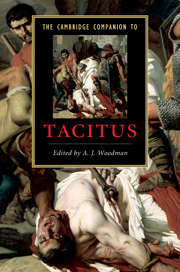Book contents
- Frontmatter
- Introduction
- Part I Contexts
- Part II Texts
- 3 The Agricola
- 4 The Germania as literary text
- 5 The faces of eloquence: the Dialogus de oratoribus
- 6 Fission and fusion: shifting Roman identities in the Histories
- 7 The Tiberian hexad
- 8 Hamlet without the prince? The Claudian Annals
- 9 ‘Is dying so very terrible?’ The Neronian Annals
- Part III Topics
- Part IV Transmission
- Chronological table
- Abbreviations and bibliography
- Index
9 - ‘Is dying so very terrible?’ The Neronian Annals
from Part II - Texts
Published online by Cambridge University Press: 28 March 2010
- Frontmatter
- Introduction
- Part I Contexts
- Part II Texts
- 3 The Agricola
- 4 The Germania as literary text
- 5 The faces of eloquence: the Dialogus de oratoribus
- 6 Fission and fusion: shifting Roman identities in the Histories
- 7 The Tiberian hexad
- 8 Hamlet without the prince? The Claudian Annals
- 9 ‘Is dying so very terrible?’ The Neronian Annals
- Part III Topics
- Part IV Transmission
- Chronological table
- Abbreviations and bibliography
- Index
Summary
Nero is portrayed by all the ancient literary sources as a dilettante with artistic pretensions, a ruler who disgraces himself by performing publicly as a chariot racer, lyre player and actor. He is also a murderer who wreaks havoc on his own family and the upper classes at Rome, the ruinous conclusion to the Julio-Claudian dynasty. In terms of composition and structure, the Neronian books are significantly different from Books 1-6. Instead of one major contrasting character to the princeps, such as Germanicus in Annals 1-2, Tacitus presents many. As Syme observed, Tacitus did not want the history of this period to be just the history of Nero. Many of these characters are put to death at the order of the princeps. By focusing on Tacitus' accounts of these deaths, we can see clearly how the historian frequently uses them to bring out strong contrasts between the characters of the victims and that of Nero, or, on occasion, to show their similarities. Such an examination will also touch on some of the central themes of the Neronian narrative.
- Type
- Chapter
- Information
- The Cambridge Companion to Tacitus , pp. 127 - 144Publisher: Cambridge University PressPrint publication year: 2010
- 4
- Cited by

